Pay-as-You-Go tolling allows drivers to pay only for the tolls they incur, offering flexibility without a fixed monthly fee. Subscription tolling involves a recurring payment, often providing discounted rates or unlimited usage within a set period. Choosing between these options depends on travel frequency and cost preferences for managing toll expenses efficiently.
Table of Comparison
| Feature | Pay-as-You-Go Tolling | Subscription Tolling |
|---|---|---|
| Payment Model | Charges applied per use or trip | Fixed monthly or annual fee |
| Cost Predictability | Variable based on usage | Consistent, budget-friendly costs |
| Best For | Infrequent toll users | Frequent toll commuters |
| Billing | Itemized per trip | Consolidated regular billing |
| Flexibility | No fixed commitment | Requires subscription agreement |
| Access Benefits | Basic toll access | Discounts, priority lanes |
Understanding Pay-as-You-Go vs Subscription Tolling
Pay-as-You-Go tolling charges drivers based on actual road usage, making it ideal for occasional travelers who want to avoid fixed fees and only pay for mileage incurred. Subscription tolling involves a recurring fee, often monthly, providing unlimited or discounted road access that suits frequent commuters and businesses seeking predictable expenses. Understanding the cost structure and usage patterns helps drivers choose the best tolling option for their travel needs and budget.
How Pay-as-You-Go Tolling Works
Pay-as-You-Go tolling charges drivers based on actual road usage, deducting fees from a linked account or prepaid balance after each trip. This system uses electronic toll collection technology, allowing seamless passage through toll points without stopping for cash payments. Real-time data tracking ensures accurate billing, making it flexible for occasional toll road users without committing to monthly fees.
Key Features of Subscription Tolling
Subscription tolling offers unlimited access to toll roads for a fixed monthly fee, eliminating the need for individual transaction payments and ensuring predictable travel costs. Key features include automatic account management, seamless electronic toll collection, and personalized usage reporting, which streamline the payment process and enhance user convenience. This model appeals to frequent travelers seeking cost efficiency and simplified billing over variable pay-as-you-go charges.
Cost Comparison: Pay-as-You-Go vs Subscription
Pay-as-You-Go tolling charges drivers based on actual road usage, making it cost-effective for infrequent travelers who prefer to pay only when they drive through toll areas. Subscription tolling often involves a fixed monthly fee, offering unlimited access or discounted per-trip rates, which benefits frequent commuters by providing predictable expenses and potential savings over time. Evaluating personal travel frequency and toll usage patterns is essential for selecting the most economical option between pay-as-you-go and subscription models.
Flexibility in Toll Payment Options
Pay-as-You-Go tolling offers maximum flexibility by allowing drivers to pay only for the tolls they incur without any upfront commitments, making it ideal for occasional users and unpredictable travel patterns. Subscription tolling provides convenience through a fixed fee, granting unlimited or discounted access on specific routes, which benefits frequent commuters seeking cost predictability. Choosing between these options depends on individual travel frequency and preference for budget control or unrestricted access.
User Suitability: Which Model Fits Your Driving Habits?
Pay-as-You-Go tolling is ideal for infrequent drivers who prefer to pay only when they use toll roads, offering flexibility without monthly fees. Subscription tolling suits frequent commuters who benefit from predictable monthly costs and potential discounts for regular usage. Evaluating your driving frequency and budget preferences helps determine the most cost-effective toll payment model.
Technology Behind Modern Tolling Systems
Modern tolling systems leverage advanced technologies such as RFID, ANPR (Automatic Number Plate Recognition), and mobile app integration to enable both Pay-as-You-Go and Subscription Tolling models. Pay-as-You-Go tolling relies heavily on real-time data processing and cloud connectivity to charge users per trip, while Subscription Tolling employs persistent user profiles stored securely in centralized databases for automated periodic billing. These technologies ensure seamless toll collection, reduce congestion, and enhance user convenience through precise vehicle identification and optimized payment processing algorithms.
Pros and Cons of Each Tolling Approach
Pay-as-You-Go tolling offers flexibility by charging drivers only for the exact road usage, reducing upfront costs but potentially leading to unpredictable expenses during frequent travel. Subscription tolling provides cost certainty and convenience through a fixed fee, simplifying budgeting but may result in overpayment for infrequent users. Evaluating travel frequency and budget preferences is essential to choose between the flexible but variable Pay-as-You-Go model and the stable but potentially less economical subscription approach.
Impact on Traffic Flow and Road Management
Pay-as-You-Go tolling dynamically adjusts traffic volumes by charging drivers per use, reducing congestion during peak hours through variable pricing models. Subscription tolling offers predictable revenue streams and encourages consistent road usage patterns, simplifying traffic management and maintenance scheduling. Both systems enhance road management efficiency, but Pay-as-You-Go provides more real-time control over traffic flow, while Subscription models improve budgeting and long-term infrastructure planning.
The Future of Toll Payments: Trends and Innovations
Pay-as-you-go tolling offers real-time billing based on actual road usage, enhancing flexibility and cost efficiency for drivers, while subscription tolling provides predictable monthly fees and added convenience through fixed plans. Emerging trends in toll payments include the integration of AI-powered dynamic pricing and blockchain technology to ensure secure, transparent transactions. Innovations such as contactless payment systems and vehicle-to-infrastructure communication are poised to revolutionize toll collection, reducing congestion and improving overall traffic management.
Pay-as-You-Go Tolling vs Subscription Tolling Infographic

 cardiffo.com
cardiffo.com